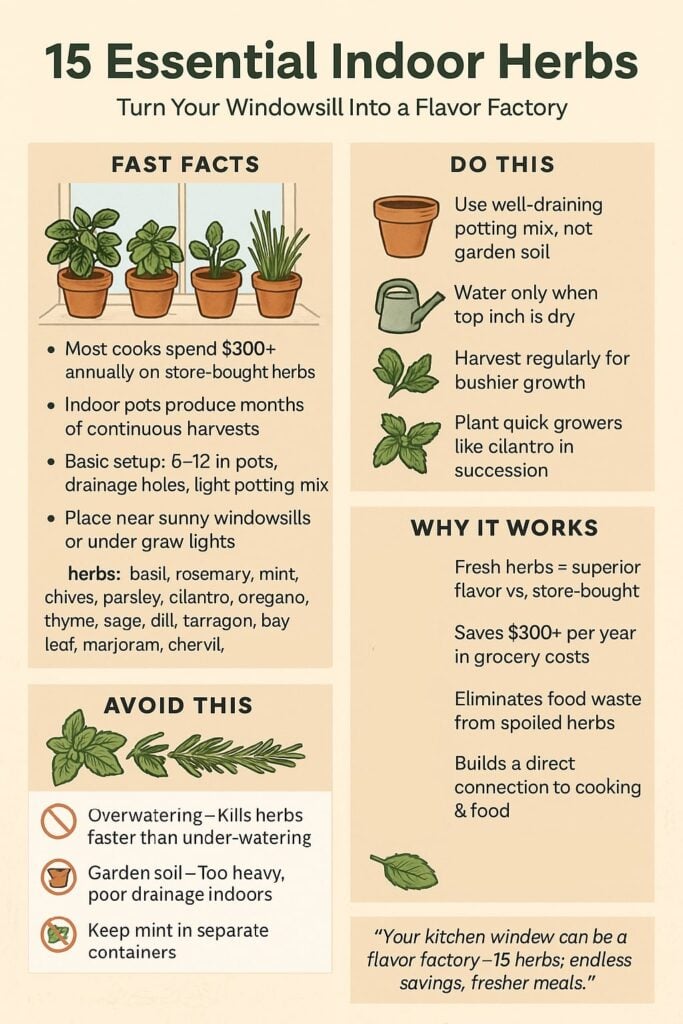
Let’s be honest. Those sad, wilting herb packets at the grocery store are highway robbery at $3 a pop.
Did you know the average home cook spends over $300 annually on fresh herbs that they could easily grow themselves?
It’s time to stop that madness and transform your windowsill into a flourishing herb paradise that’s always ready when inspiration strikes!
Why Your Kitchen Deserves an Herb Revolution
Forget what you’ve heard about indoor gardening being complicated. Growing herbs at home is like having a tiny flavor factory that works overtime while you sleep.
Store-bought cilantro gives you maybe three days before it turns into sad green slime. Meanwhile, a potted herb keeps producing for months!
The secret most plant experts won’t tell you is that herbs are actually some of the most forgiving plants you can grow.
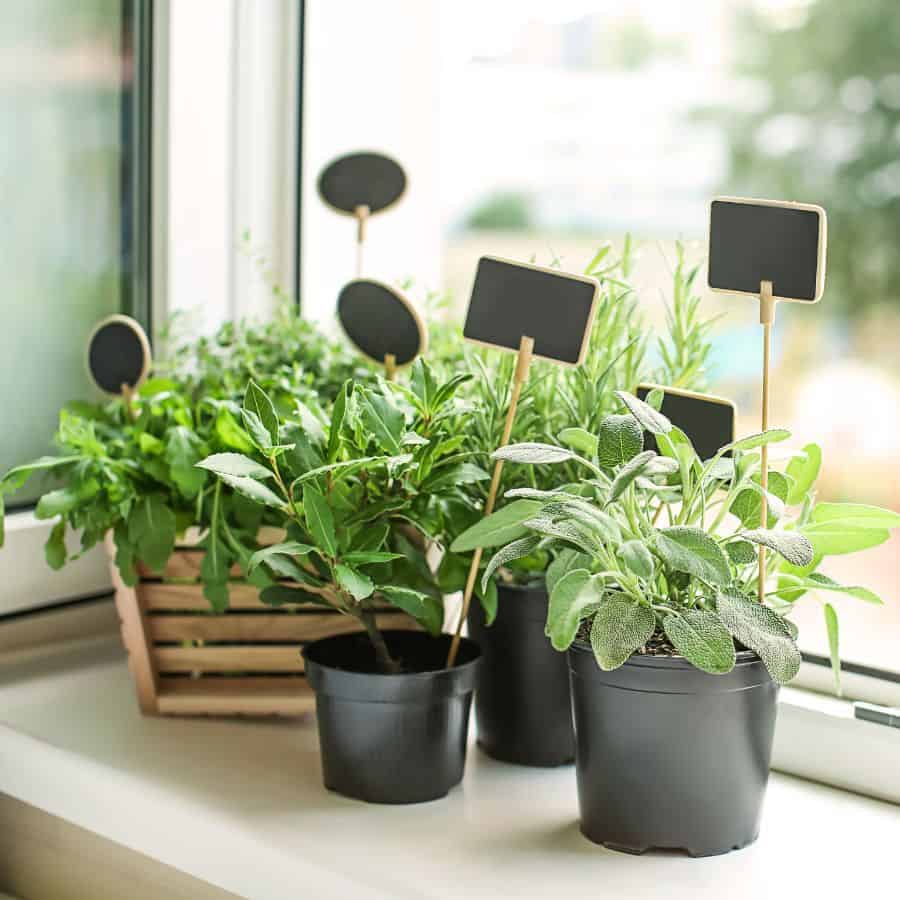
They’re like the loyal golden retrievers of the plant world. Rager to please and surprisingly resilient even when you forget about them for a bit.
Beyond the obvious money-saving perks, homegrown herbs deliver flavor bombs that their store-bought cousins can only dream of.
When you snip herbs seconds before they hit your pan, you’re experiencing them at their aromatic peak. Something that’s literally impossible with herbs that have been sitting in plastic for days.
The Dirt-Simple Setup That Guarantees Success
Ready to play plant parent? Here’s your no-fail starter kit:
- Containers: 6-12-inch pots with drainage holes (old coffee mugs with holes drilled work too!)
- Soil: Light, well-draining potting mix (avoid garden soil, which is basically herb quicksand)
- Light: A sunny window or inexpensive LED grow lights
- Tools: Small watering can, scissors, and spray bottle
Most people make this mistake with their indoor herbs: they drown them with love.
These plants generally need water only when the top inch of soil feels dry, kind of like how you only need coffee when your brain feels dry. Over-watering is the fastest way to send your herbs to plant heaven.
The Magnificent 15: Your Year-Round Flavor Squad
1. Basil: The Drama Queen That’s Worth It
Basil demands attention like a social media influencer, but rewards you with spectacular flavor. Keep it warm, give it plenty of sun, and pinch back the top leaves regularly to prevent flowering.
The difference between amateur and pro plant parents is simply knowing that basil needs to be harvested constantly to stay bushy and productive.
2. Mint: The Herb That Wants to Take Over Your Life
This vibrant overachiever will grow so enthusiastically you might suspect it’s trying to stage a household coup.
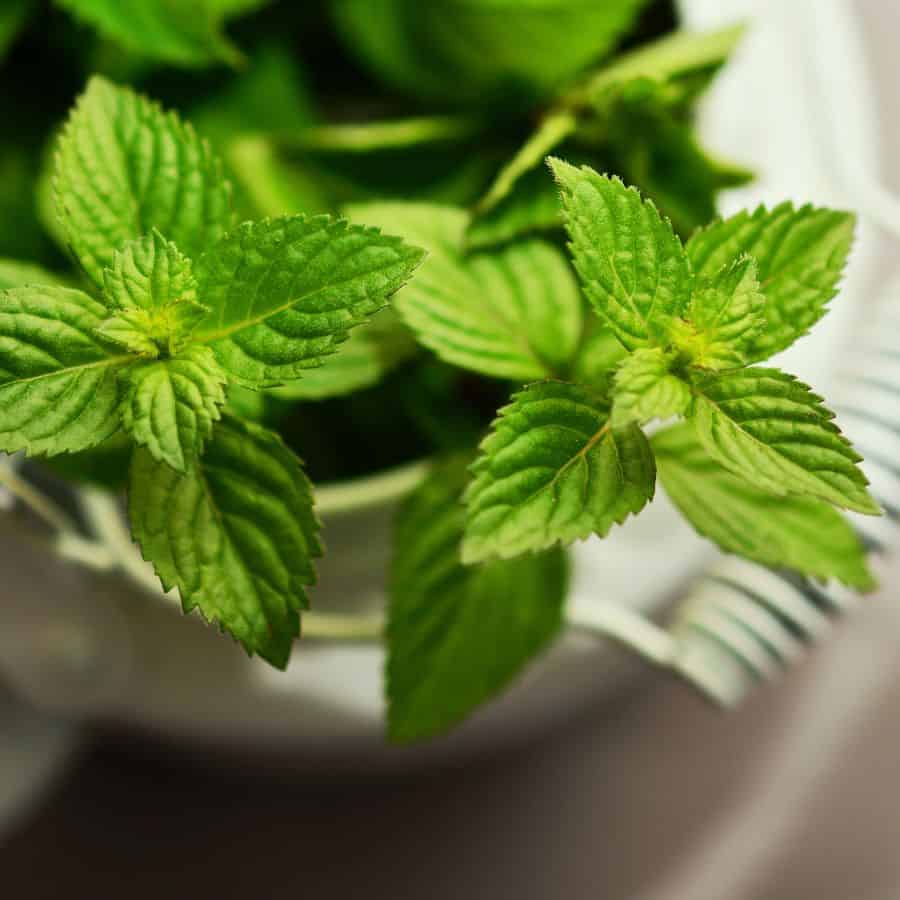
Keep mint in its own container unless you want a mint jungle. It thrives in partial sun and loves consistently moist soil. Your mojitos and summer salads will never be the same!
3. Rosemary: The Mediterranean Survivor
Think of rosemary as the desert cactus of herbs: drought-tolerant and sun-loving. This woody herb has a robust pine-like flavor that transforms ordinary chicken into restaurant-quality fare.
The game-changer for your rosemary isn’t what you think. It’s actually letting it dry out completely between waterings.
4. Thyme: The Tiny-Leaved Flavor Giant
Thyme is the quiet herb that speaks volumes in your cooking. This low-maintenance superstar prefers full sun and dry conditions.
It’s practically begging to be neglected! Its concentrated flavor makes it perfect for slow-cooked dishes where it can work its magic over time.
5. Parsley: Not Just Your Plate’s Green Decoration
I was shocked to discover that parsley contains more vitamin C than oranges! This underappreciated herb deserves center stage.
It needs consistent moisture and bright light to thrive. Whether you choose flat-leaf (more flavor) or curly (prettier garnish), parsley will elevate everything from tabbouleh to chimichurri.
6. Cilantro: Love It or Hate It, It’s Easy to Grow
Cilantro (or coriander if you’re fancy) grows so quickly you can practically watch it happen. It prefers cooler temperatures, making it ideal for shaded areas.
Pro tip: plant new seeds every few weeks for a continuous harvest, as cilantro is the sprinter of herbs; quick to bolt when temperatures rise.
7. Chives: The Cut-and-Come-Again Wonder
These slender onion relatives are perhaps the most rewarding indoor herb. Snip them an inch above the soil, and they’ll regrow like they’ve been taking resurrection lessons.
Chives thrive in bright light and consistent moisture. Their delicate onion flavor is the secret weapon in everything from scrambled eggs to baked potatoes.
8. Oregano: The Pizza Perfector
Your homemade pizza is desperate for this Mediterranean hero. Oregano thrives in bright light and likes to dry out between waterings.
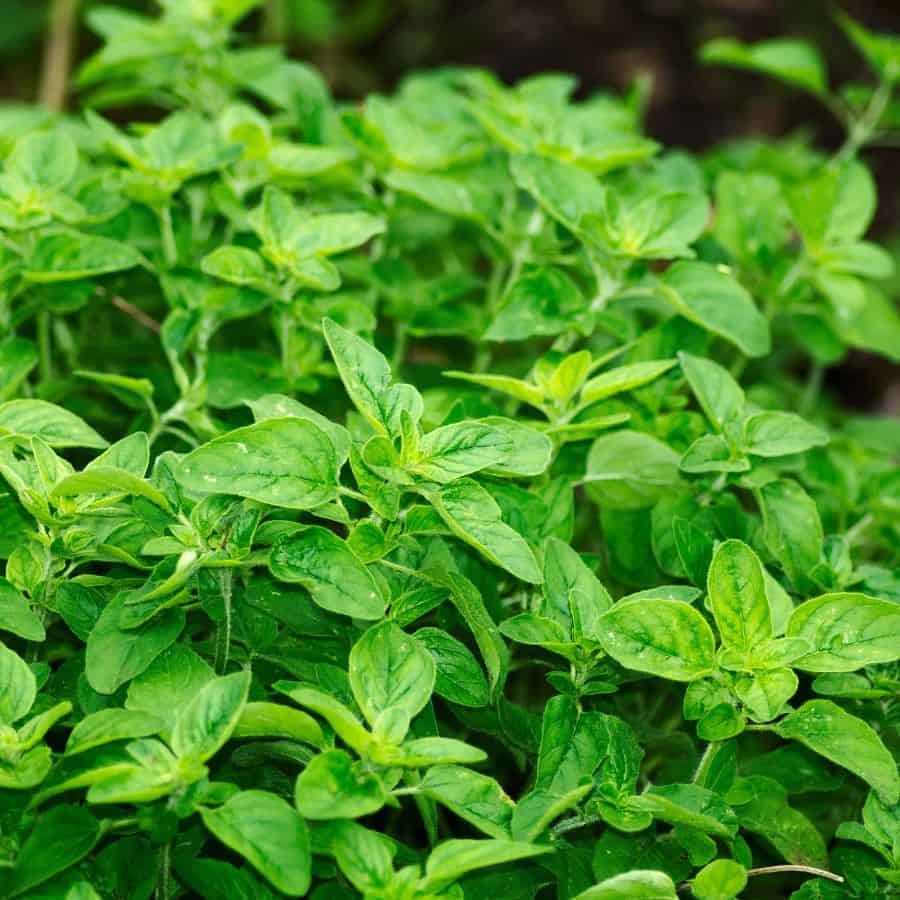
Its flavor actually intensifies when grown in slightly stressed conditions, making it the rare plant that improves with a bit of neglect. (If only the same were true for relationships!)
9. Sage: The Velvety Thanksgiving Essential
With its soft, gray-green leaves and earthy flavor, sage deserves a spot in your herb collection. It’s drought-tolerant and sun-loving, making it perfect for that hot windowsill where other plants would throw a fit.
Frying fresh sage leaves in butter creates a gourmet garnish that will make your guests think you went to culinary school.
10. Dill: The Feathery Pickle Enhancer
Dill’s feathery foliage isn’t just pretty. It packs a punch in everything from salmon dishes to homemade pickles.
It grows quickly in full sun and moist soil. Your dill is trying to tell you something important when it starts to flower. Harvest those seeds for planting and cooking!
11. Lavender: The Stress-Relieving Double Agent
This aromatic beauty serves double duty as both a cooking ingredient and a natural air freshener.
Lavender needs full sun and excellent drainage. Think Mediterranean vacation conditions. Use it sparingly in baked goods for a floral note that will have everyone asking for your secret ingredient.
12. Lemon Balm: The Mood Booster
This lemon-scented member of the mint family brings sunshine to teas and desserts. It grows vigorously in partial sun and regular moisture.
The secret most garden experts won’t tell you is that the more you harvest lemon balm, the more it produces. It’s like the herb equivalent of a motivated employee.
13. Tarragon: The French Chef’s Best Friend
With its delicate anise flavor, tarragon transforms ordinary chicken and fish into restaurant-worthy fare.
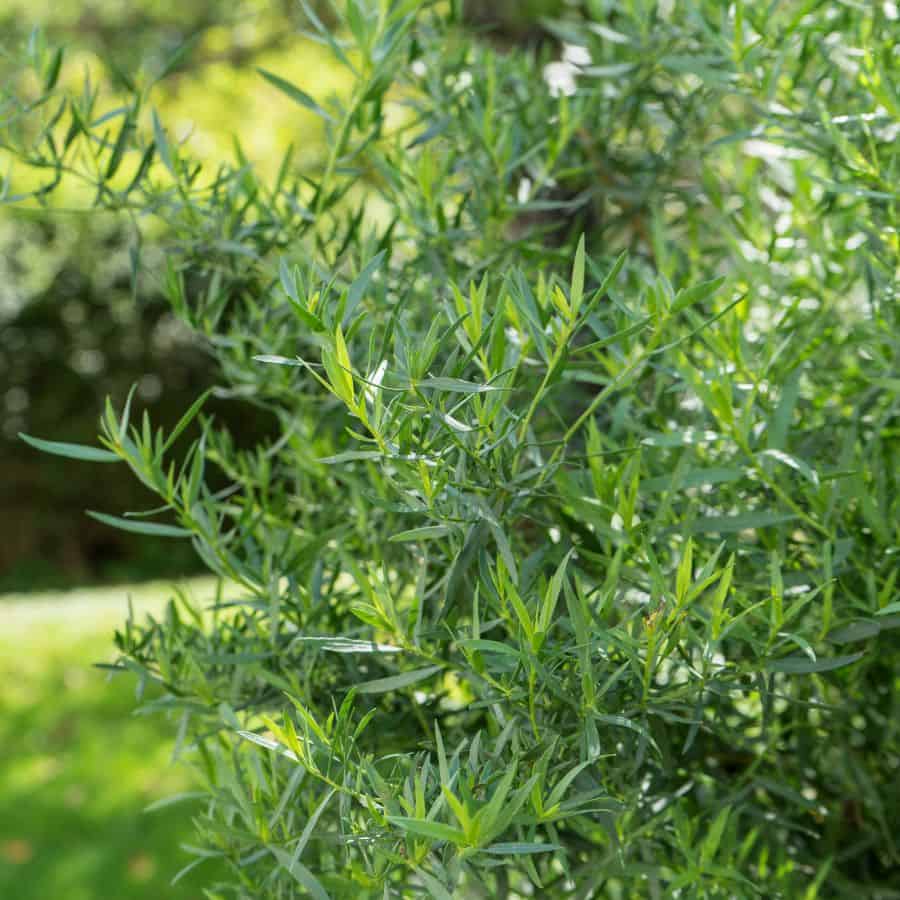
It prefers bright, indirect light and moderate watering. Growing tarragon at home gives you access to a fresh herb that’s often impossible to find in stores.
14. Bay Leaf: The Long-Term Relationship Herb
This slow-growing aromatic leaf is the marathon runner of herbs, in it for the long haul.
A single bay plant can provide leaves for years! It prefers bright light and moderate watering. One fresh bay leaf delivers more flavor than an entire jar of dried ones from the store.
15. Marjoram: Oregano’s Gentler Cousin
This underrated herb has a sweeter, milder flavor than oregano. It flourishes in full sun and well-draining soil.
Marjoram is the secret weapon in Mediterranean cooking that will have your guests wondering how your simple dishes pack so much flavor.
From Herb Grower to Kitchen Wizard
Having these 15 herbs at your fingertips will transform your cooking from “meh” to “mind-blowing.” No more last-minute store runs or compromising on recipes because you don’t have fresh herbs.
Instead of spending $300+ yearly on store-bought herbs that die in your fridge, invest once in seeds or seedlings and reap the rewards for seasons to come.
Remember, growing herbs isn’t just about saving money. It’s about connecting with your food in a way that’s been lost in our pre-packaged world.
There’s something deeply satisfying about snipping fresh herbs you’ve grown yourself. It’s like a tiny high-five from Mother Nature every time you cook!
Ready to ditch those plastic herb packages forever? Your windowsill herb garden awaits, and trust me, your taste buds, wallet, and the planet will thank you.